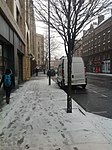Leadenhall Street

Leadenhall Street () is a street in the City of London. It is about 1⁄3-mile-long (0.54 km) and links Cornhill in the west to Aldgate in the east. It was formerly the start of the A11 road from London to Norwich, but that route now starts further east at Aldgate. Leadenhall Street has always been a centre of commerce. It connected the medieval market of Leaden Hall with Aldgate, the eastern gate in the Roman city wall. The East India Company had its headquarters there, as later did the Peninsular and Oriental Steam Navigation Company (P&O). By the mid 20th century, grand stone-faced offices lined the street. Today it is closely associated with the insurance industry and particularly the Lloyd's insurance market, with its dramatic building in the adjacent Lime Street. It forms part of a cluster of tall buildings including the 48-storey “Cheesegrater” and the 38-storey “Scalpel”. Other buildings planned for the street include the 57-storey “Diamond”, the 50-storey “Prussian Blue” and the 34-storey “Gotham City”. Older buildings like the medieval church of St Katherine Cree seem incongruous among these towers, but the medieval heritage is preserved in the narrow slightly curving street and dense commercial activity.
Excerpt from the Wikipedia article Leadenhall Street (License: CC BY-SA 3.0, Authors, Images).Leadenhall Street
Leadenhall Street, City of London
Geographical coordinates (GPS) Address Nearby Places Show on map
Geographical coordinates (GPS)
| Latitude | Longitude |
|---|---|
| N 51.51346 ° | E -0.081 ° |
Address
Leadenhall Street 107-112
EC3A 4AA City of London
England, United Kingdom
Open on Google Maps






